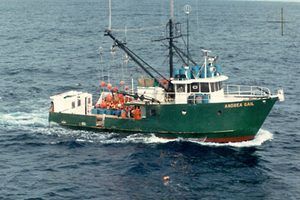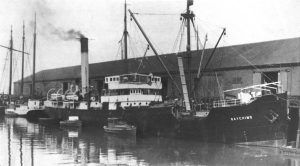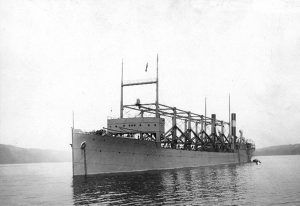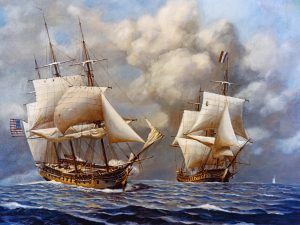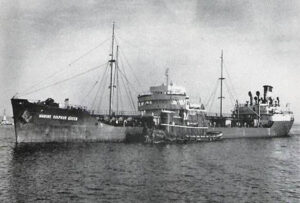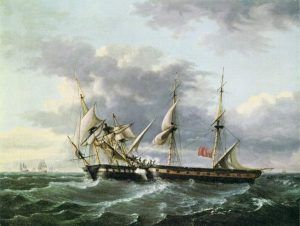There are dozens of missing and unexplained disappearances of American ships and boats where no evidence of the ship or crew has ever been found. Here are just some of the notable ones lost.
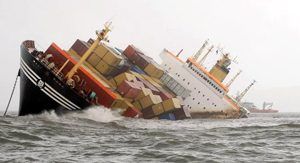
Sinking Ship
Missing American Ships:
Andrea Gail – Lost in the Perfect Storm
SS Baychimo – Disappeared in the Arctic
USS Cyclops – Lost in the Bermuda Triangle
USS Insurgent – Missing Frigate
SS Marine Sulphur Queen – Not Seaworthy
S.S. Poet – Victim of the Atlantic
USS Wasp – The Victor Disappears
Witchcraft – An Unsinkable Luxury Yacht
Andrea Gail – Lost in the Perfect Storm
A fishing trawler, the Andrea Gail, was lost at sea with its six crew members during the “Perfect Storm” of 1991. The 72-foot commercial fishing vessel was built in Panama City, Florida, in 1978 and owned by Robert Brown. Holding a crew of six, she was in commission for 13 years before vanishing on a trip to Newfoundland.
The Andrea Gail and her six-man crew had been fishing in the North Atlantic Ocean out of Gloucester, Massachusetts. On September 20, 1991, the Andrea Gail and a fleet of about 25 sword fishing vessels set out from Gloucester for the last fishing trip of the season bound for the Grand Banks of Newfoundland off the coast of eastern Canada. Loaded with ice, the crew hoped to catch some 40,000 pounds of swordfish — the sooner, the better, so they could get back home and share in the profits.
But, the crew wasn’t catching as many fish as they had hoped, and by the middle of October, they had barely enough fish to break even. As a result, Captain Frank William “Billy” Tyne headed east to the Flemish Cap, where he believed they would have better luck. At some point, the ship’s ice machine began to malfunction and would be unable to maintain the catch for much longer. Tyne then decided to set a course for home on about October 26 despite weather reports of dangerous conditions.
They were off the coast of Newfoundland when a high-pressure system slammed into a low-pressure system, which then merged with the remains of Hurricane Grace, creating what has been dubbed “the perfect storm.” Battered by massively powerful winds and waves as high as 100 feet, Captain Tyne’s last radio transmission noted: “She’s comin’ on boys, and she’s comin’ on strong.” Her last reported position was 180 miles northeast of Sable Island at 6:00 p.m. on October 28, 1991.
The devastating storm battered the coast of New England and Canada, and after the worst of it had passed and the Andrea Gail had failed to return to port, several rescue missions, including the New York Air National Guard, the U.S. Coast Guard, and the Canadian Coast Guard set out on an extensive air and sea search. Though they covered 186,000 square nautical miles, nothing was found but the ship’s emergency beacon and a few pieces of debris. After a week of searching, the Andrea Gail and her crew were declared lost.
Weeks later, fuel drums, a propane tank, an empty life raft, and radio equipment were found.
The crew members lost included:
- Captain Frank William “Billy” Tyne, Jr., age 37, Gloucester, Massachusetts
- Michael “Bugsy” Moran, age 36, Bradenton Beach, Florida
- Dale R. “Murph” Murphy, age 30, Bradenton Beach, Florida
- Alfred Pierre, age 32, New York City
- Robert F. “Bobby” Shatford, age 30, Gloucester, Massachusetts
- David “Sully” Sullivan, age 28, New York City
The story of the storm and the imagined fate of Andrea Gail and her crew was later told in Sebastian Junger’s book The Perfect Storm and a Hollywood movie of the same name.
The SS Baychimo – Disappeared in the Arctic
A modern maritime mystery, some would call the SS Baychimo ghost ship. Abandoned in 1931, she continued to sail without a crew for decades — last being sighted in 1969.
The large 1,322-ton steam-powered cargo ship, the Angermanelfven, was first launched in 1914 by the Lindholmens shipyard in Gothenburg, Sweden. The 230-foot-long ship was first used on trading routes between Hamburg and Sweden until World War I began in August 1914. When the war was over, she was transferred to the United Kingdom as part of Germany’s reparations for shipping losses. The Hudson’s Bay Company acquired the ship in 1921 and rechristened the Baychimo. Based out of Ardrossan, Scotland, she was primarily utilized for transporting furs from northern Canada but also sometimes carried other cargo and passengers. Trading with the Inuit settlements along the coast of the Northwest Territories of Canada, she made nine successful journeys before her luck ran out in 1931.
At the end of a trading run on October 1, 1931, the Baychimo was loaded with fur pelts. Winter had come early that year, and the crew and the ship were unprepared for the bitter weather. As they sailed along the choppy waters, a blizzard hit them, bringing chunks of ice surrounding the ship, eventually trapping the vessel in pack ice. Unable to continue the voyage, the captain ordered the crew to disembark and make their way on foot across the shifting ice floes to the town of Barrow, Alaska, over a half-mile away. There, the crew took shelter for two days before returning to check on the status of their abandoned ship. They found that the Baychimo had broken free of the ice and was aimlessly drifting about the sea. They then built a camp on the ice where they could keep an eye on the vessel. The severe weather continued, and the ship was mired in ice on October 8.
On October 15, with the weather conditions showing no signs of letting up, the Hudson’s Bay Company sent an aircraft rescue party to evacuate the camp. Although 22 of the crew were rescued, the captain and 14 other crew members refused to abandon their ship and its cargo and opted to remain camped out on the ice despite the punishing storm. Receiving provisions from the company and building a wooden shelter, they were prepared to stubbornly wait out the winter if required. On November 24, a mighty blizzard struck the region again, and when it was over, the Baychimo disappeared. Her captain concluded that the ship must have broken up during the storm and sunk.
However, a few days later, an Inuit seal hunter came upon the camp, telling the Captain and the remaining crew that he had sighted the ship about 45 miles away. The vessel was then found, but determining it was unlikely to survive the winter, the most valuable cargo was offloaded, and the Baychimo was finally abandoned in the icy sea.
Though the ship should have been destroyed in the winter storms, no one gave her the credit she deserved, as she would be repeatedly sighted across the Arctic, drifting aimlessly for more than three decades. People managed to board her several times, but each time they were either unequipped to salvage her or were driven away by bad weather. The last time she was boarded was in 1939. But, still, she drifted across the Arctic unmanned, seen close to shore at times and others far out to sea. The ship was last seen frozen in an ice pack in 1969, 38 years after she was abandoned. This is the last recorded sighting of Baychimo.
In 2006, the Alaskan government began work on a project to solve the mystery of “the Ghost Ship of the Arctic” and locate Baychimo, whether still afloat or on the ocean floor. However, the ship nor any trace of wreckage was found.
USS Cyclops – Lost in the Bermuda Triangle
A massive carrier ship that supplied fuel to the American fleet during World War I, the USS Cyclops, along with her 309 crew members and passengers, went missing in the Bermuda Triangle area sometime after March 4, 1918, and was never seen again.
The ship, named for the Cyclops, a primordial race of giants from Greek mythology, was first launched on May 7, 1910, by William Cramp and Sons of Philadelphia and placed in service to the Navy on November 7, 1910. Operating with the Naval Auxiliary Services, she voyaged the Baltic Sea from May through July 1911, supplying Second Division ships before returning to Norfolk, Virginia. She then operated on the east coast from Newport, Rhode Island, to the Caribbean, servicing the fleet. During the United States occupation of Veracruz in Mexico in 1914–1915, she fueled ships on patrol and evacuated refugees.
When the United States joined World War I, the Cyclops was commissioned on May 1, 1917, and joined a convoy for Saint-Nazaire, France, in June 1917. She returned to the United States the next month and served along the east coast until January 9, 1918. The ship was then assigned to the Naval Overseas Transportation Service and sailed to Brazilian waters to fuel British ships in the South Atlantic.
In Rio de Janeiro, Commander Worley reported that the Cyclops’ starboard engine was inoperative because it had a cracked cylinder, reducing her speed to ten knots. As a result, the ship was ordered to return to the United States for repairs. On February 15, 1918, the ship departed Brazil carrying more than 12,000 tons of manganese ore used to produce munitions. Five days later, she stopped in Salvador, Brazil, on February 20. After two days, she set sail again, headed to Baltimore, Maryland, with no scheduled stops. However, the ship deviated to Barbados along the way, landing on March 3, some 1,800 nautical miles from its destination. The Cyclops left the next day and was never seen again.
The Cyclops was scheduled to reach Baltimore on March 13, and when she didn’t, a massive search, including boats and planes, was initiated along her entire course. However, no trace of the ship, debris, or survivors was ever found.
On June 1, 1918, Assistant Secretary of the Navy Franklin D. Roosevelt declared Cyclops to be officially lost and all hands deceased.
So, what happened to USS Cyclops?
Though the Naval History & Heritage Command has stated she “probably sank in an unexpected storm,” the actual cause of the ship’s fate is unknown.
Several other theories exist, including sabotage. Captain Worley had often been accused of being pro-German and was disliked by many of his officers and staff. Later it was found that the captain was German-born and had changed his last name. Also boarding the ship in Rio de Janeiro was American Consul-General Gottschalk, purportedly to return to the United States to enlist in the U.S. Army. However, Gottschalk was known to have been very popular among the German community in Brazil. Did one or both of these gentlemen conspire to destroy the ship? Why was there no SOS call made by the captain?
A second theory is that the ship was not seaworthy while carrying such a heavy load. Reportedly, the ship’s maximum load capacity was 8960 tons, but she had taken on more than 12,000 tons of ore in Brazil. Reports of the unscheduled stop in Barbados indicate the Cyclops had landed due to the water level over the Plimsoll line, indicating an overloaded condition. However, investigations in Rio proved the ship had been loaded and secured properly, so the ship moved on. Did its overloaded condition and the cracked engine cylinder cause the Cyclops to sink?
Was the ship blasted by a German underwater mine or torpedoed by a German Sub? U.S. Navy claims the possibility would not exist if the ship had been on its right course. However, had the ship been off its track by a large margin, there was a high possibility of that happening, and the ship would have perished. However, German authorities at the time, and subsequently, denied any knowledge of the vessel.
Though the Navy conducted a full investigation and provided a 15,000-page report filled with facts and evidence, no conclusion was ever made to the Cyclops’ disappearance. Instead, the report concluded, “Many theories have been advanced, but none that satisfactorily accounts for her disappearance.”
This summation was written, however, before two of Cyclops’ sister ships, the Proteus and Nereus vanished in the North Atlantic during World War II. Both ships were transporting heavy loads of metallic ore similar to that which was loaded on Cyclops during her fatal voyage. In both cases, it was theorized that their loss resulted from catastrophic structural failure.
Afterward, it was theorized that all three ships sank due to structural failure. It is known that Cyclops’ sister ships suffered from issues with the I-beams that ran the length of the ship, which had eroded due to the corrosive nature of some of the cargo carried. This problem was also seen in other similar freighters, one of which was known to have snapped in two on calm seas.
Did the USS Cyclops sink to the ocean floor for one of these reasons, or does the answer lie with the many other missing vessels that have succumbed to the mysteries of the Bermuda Triangle?
The disappearance of the Cyclops remains the single largest loss of life in U.S. Naval history, not directly involving combat.
The USS Insurgent – Missing Frigate
Originally a 40-gun frigate of the French Navy, L’Insurgente was built by Pierre-Joseph Pénétreau at Lorient, France, and launched on April 27, 1793. Five years later, in 1798, the Quasi-War, which was also known as “The Undeclared War with France,” the “Pirate Wars,” and the “Half War,” erupted. This undeclared war fought almost entirely at sea between the United States and the French Republic, began due to the failure of the United States to repay its considerable debts to France incurred during the American Revolution. When the French crown was toppled during the French Revolutionary Wars, the United States refused to continue repaying its debt to France because it had been owed to a previous regime. This resulted in France retaliating with privateering attacks against American vessels. In response, the United States went on the offensive and sent four naval squadrons into the Caribbean to seize armed French vessels and prevent privateers from attacking American ships.
One of the squadrons included the USS Constellation under the command of Commodore Thomas Truxtun, which came upon the L’Insurgente on February 9, 1799, northeast of Nevis. When the French ship fired on the Constellation, a battle lasted over an hour, in which the Americans outmaneuvered the crew of L’Insurgente, forcing her to surrender.
When the Americans boarded the French vessel, they found that she had lost 70 men from a crew of 409, while the Constellation, though badly damaged, had lost only three of her crew of 309 men.
This was the first post-Revolutionary War American victory against a foreign naval ship.
Afterward, the frigate was taken to the West Indies and refitted for service in the American Navy. Renamed the Insurgent, she cruised with the USS Constellation until May 1799, winning many victories and capturing five more ships before returning to the United States in early 1800. On April 29, 1800, Patrick Fletcher assumed command. He was ordered to cruise between the West Indies and the American coast to protect American shipping interests and to capture any enemy vessels he encountered.
On July 22, 1800, the Insurgent departed Baltimore, Maryland, and after a brief stop at Hampton Roads, she sailed southward on August 8. She was never heard from again and was presumed to have been caught in a severe storm that struck the West Indies on September 20, 1800.
That same month, the Quasi-War ended with the signing of the Treaty of Mortefontaine.
SS Marine Sulphur Queen – Not Seaworthy
The SS Marine Sulphur Queen was originally an oil tanker utilized in World War II that was converted to carry molten sulfur. The 524-foot ship disappeared off the coast of Florida, taking with her the lives of 39 crew members.
Originally named S.S. Esso New Haven, the Sun Shipbuilding and Dry Dock Company built the vessel in Chester, Pennsylvania, in March 1944. It was just one of many T2 tankers built to carry and transport oil. In 1960, she was placed in a dry dock, converted to carrying a cargo of molten sulfur, and rechristened the Marine Sulphur Queen.
The ship’s last voyage began on February 2, 1963, out of Beaumont, Texas, with a cargo of sulfur weighing 15,260 tons destined for Norfolk, Virginia. On February 4, near Florida, an ordinary radio message was sent by a crewman, giving the ship’s position. That was the last report made by the Marine Sulphur Queen. The ship was listed as missing two days later, and a search for the vessel and her 39 crew members was begun. The Marine Sulphur Queen was thought to have gone down somewhere in the Straits of Florida, and though the search continued for 19 days, only a few life preservers and some debris were ever found.
The Coast Guard immediately launched an investigation that primarily questioned the ship’s seaworthiness, even stating that its condition should have prevented it from going to sea.
One of the most severe problems discovered was that the ship had a history of fires beneath and along the sides of the four large sulfur tanks. In fact, according to former crewmen, these fires were so common that the ship’s officers gave up sounding the fire alarm. It was also found that the T2 tanker class had a characteristic “weak back,” meaning the keel would split at a point weakened by corrosion. Such a splitting had happened on several other T2 tankers. Its loss was determined to have been caused by the ship’s poor design and lack of maintenance. One former crew member called the ship “a floating garbage can.” This was reinforced by several crewmen who reported that corrosion was everywhere, causing inoperable equipment.
Interestingly, the Marine Sulphur Queen had been scheduled for a drydock inspection in January 1963. Still, the owners postponed it, complaining that cargo deliveries were running behind and that they needed their ships to catch up. Ultimately, the Coast Guard recommended that no remaining T2 tankers be converted to sulfur carriers. This would result in lengthy litigation between the ship’s owners and the families of the missing men.
The S.S. Poet – Victim of the Atlantic
Initially built as a transport ship for the U.S. Navy in 1944, she regularly transported troops during World War II until 1949. Afterward, she was idle for two decades before being sold and changing hands several times. In 1979, she was purchased by the Hawaiian Eugenia Corp, and the 522-foot ship was converted to a bulk cargo carrier.
On October 24, 1980, the Poet left Girard Point in Philadelphia, Pennsylvania, early in the morning carrying 13,500 tons of corn and a crew of 34. Bound for Port Said, Egypt, the captain reported that the ship was heavy on the bow and was slow in responding. However, these issues were of little concern as the green light signal was given to the ship, and it began cruising through the Delaware River towards the Atlantic. A short time later, the ship reported its position at 8:30 a.m. when it passed by Cape Henlopen, Delaware. It would be the last transmission received from the Poet.
Though the ship was required to report its position to the Marine Administration every two days, it failed to do so, and for whatever reason, the ship owners didn’t report her missing until November 3, 1980. Had the ship stayed the course, she would have reached Egypt by then. Unfortunately, the delay in reporting the Poet’s missing made the search for her much more difficult. However, the U.S. Coast Guard initiated a massive search operation covering 290,000 square miles starting from Cape Henlopen to the Straits of Gibraltar. In addition, nine planes did an aerial search of some 393,000 square miles. In the end, no trace of the ship, the 34-member crew, nor any debris or oil leakage was found.
A Marine Board investigation was initiated to determine what had happened to the ship, but no specific conclusion was determined. However, several facts that may have had something to do with her appearance were uncovered.
On October 26, a short auto alarm was received at the radio control tower in Baltimore, Maryland. It was so short that it could not be determined that it came from the Poet, but if it did, the location indicated the ship was in the midst of the Bermuda Triangle, at the edge of the Sargasso Sea.
The Coast Guard inspected the ship before leaving Philadelphia. Though the inspection found some issues, they were not considered risky enough to stop her from going to sea. One problem was that a couple of large oil containers did not have padding under them, making them susceptible to sparks. The hatch of one of the cargo holders was found to be defective, which could have caused it to give way and the hold to flood. However, the defect was not considered a real threat as it had been that way for some time. The ship did not have a Loran navigational system. Still, it is unlikely that this was a problem as the veteran captain had 41 years of experience and had traveled the route multiple times. Lastly, the ship was listing slightly before it departed; however, this imbalance could be corrected by shifting barrels of fuel.
On October 25, a freak storm with 30-foot high seas and high winds gusting up to 60 knots occurred in the North Atlantic. Though the Poet had survived worse in the past, might she have succumbed to this storm?
The final Maritime Report produced by the Coast Guard mentioned that the Poet was likely lost between October 25th and 26th when it faced the worst weather conditions.
It was the first U.S. vessel to have disappeared in many years.
USS Wasp – The Victor Disappears
A sloop-of-war that served in the U.S. Navy in 1814 during the War of 1812, the USS Wasp was built in 1813 at Newburyport, Massachusetts, by Cross & Merrill and commissioned early in 1814.
The fast-moving ship with a square sail, 22 guns, and a crew of around 170, she carried out two successful raiding voyages against British trade during the summer of 1814, in which she fought and defeated three British warships. In total, the Wasp fought 13 successful engagements and was a valuable asset to the United States Navy.
Then, on September 22, 1814, she captured the British merchant brig, Atalanta. Usually, the Wasp’s crew would burn enemy ships. However, the Atalanta was deemed much too valuable to destroy (it may have helped that the Atalanta was a prize won back for the U.S. — she had previously been an American ship called the Siro). Instead, a crew was dispatched to bring her into a friendly harbor. After the Atalanta departed, Master Commandant Johnston Blakeley and his remaining crew sailed on, with a Swedish merchantman reportedly spotting the Wasp heading for the warm waters of the Caribbean. After that, she disappeared, never to be seen again. In all probability, she sank in a storm — but no trace of the ship or crew was ever found.
The Witchcraft – An Unsinkable Luxury Yacht
On the night of December 22, 1967, experienced yachtsman and hotel owner Dan Burack and his friend, Father Patrick Horgan, set sail in the 23-foot luxury cabin cruiser Witchcraft to see the Christmas lights off the coast of Miami, Florida. Unfortunately, just one mile offshore, the yacht hit something below, and at 9:00 p.m., Burack calmly called the Miami Coast Guard to report the trouble and request assistance. The official who took the call later commented that Burack seemed unconcerned, and he had every reason to be, as his ship was “unsinkable,” or so he thought. The yacht was fitted with a special hull to keep her from sinking and was equipped with all manner of life-saving gear on board. Burack had given his location and promised to fire flares when he saw the Coast Guard.
Just 19 minutes after Burack had made the call, the Coast Guard arrived at the scene and were surprised to find no trace of the large yacht, no debris, and no sign of Burack or Horgan.
Over the next six days, hundreds of square miles of ocean were searched, including northward to the Gulf Stream in case a brief squall had pulled the ship out. After searching over 24,500 square miles, nothing was found of the men or the yacht. The Coast Guard even notified the private vessels up to 50 miles away to look out for debris. Still, nothing was found.
No explanation has ever been given for Witchcraft’s sudden disappearance. Seemingly, this was yet another vessel succumbing to the mysterious Bermuda Triangle.
©Kathy Alexander/Legends of America, updated March 2024.
Also See:
Disappearances & Mysterious Deaths
Legends, Ghosts, Myths & Mysteries
Sources:
Awesome Stories
Bermuda Attractions – Cyclops
Bermuda Attractions – Poet
Boater Exam
List Verse
Mental Floss
Mysterious Universe
Navy History
Washington Post
Wikipedia – Andrea Gail
Wikipedia – Baychimo
Wikipedia – Cyclops
Wikipedia – Insurgent
Wikipedia – Marine Sulphur Queen
Wikipedia – Wasp

